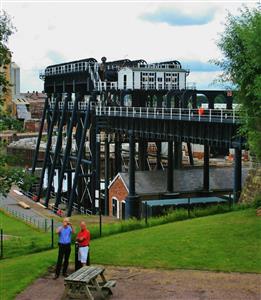
The Anderton Boat Lift
The Trent and Mersey Canal begins, as you would expect, within a few miles of the River Mersey,(it makes a straight on connection with the Bridgewater canal on the far side of Preston Brook tunnel,
ie the tunnel is part of the Trent and Mersey) near Runcorn and finishes in a junction with the River Trent in Derbyshire.
It is just over ninety miles long and takes about six days to cruise.
It is one of the earliest canals, built by Brindley, with much of historical interest, passing through some pleasant countryside.
It struggles from the Cheshire plains up thirty one locks, often called Heartbreak Hill,
to cut beneath Harecastle Hill in a spooky and watery tunnel one and three quarter miles long.
It passes through the industry of the Staffordshire Potteries out into rural Staffordshire and then Derbyshire.
Shardlow, near the River Trent, is one of England's best preserved canal towns. Try the Swan pub at Fradley Junction which has an excellent view of the junction.
Stone has some interesting old canal buildings. Shrugborough Hall dates from the 17th century and is surrounded by a landscaped park,
the Gatehouse is the size of many mansions! An English Civil war battle was fought just to the north at Hopton Heath.
Josiah Wedgwood was involved in getting the canal built and the Wedgwood factory and museum are canalside just south of Stoke on Trent.
Middlewich and Northwich are salt towns dating back to Roman times.
The canal is known for its tunnels, at Harecastle, Barnton, Saltersford and Preston Brook.
Saltersford has a kink because tunnelling started at different points and didn't quite meet in the middle!
Preston Brook has a large central chamber where a collapse was repaired, and cruising through the pitch dark confines of Harecastle tunnel is an experience nobody forgets!
The double locks on Heartbreak Hill in Cheshire were built in the last century to reduce queues, but many are now unworkable and some have been filled in.
The locks got their name not because there are so many, but because they are rarely close enough together to walk and work easily.
To real boatpeople they were just the Cheshire Locks!